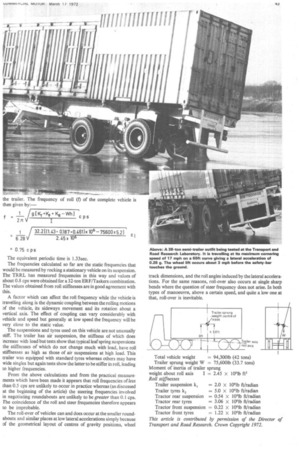Does roll frequency affect commercial vehicle roll-over?
Page 44

Page 45

If you've noticed an error in this article please click here to report it so we can fix it.
by B. S. Riley, Transport and Road Research Laboratory
Experiment and calculation suggests that roll frequency is not a major factor in heavy-vehicle overturning. Roll-over of commercial vehicles can occur at the smaller roundabouts at low speeds simply because of the geometrical layout of the vehicle. Above a certain speed — and quite a low one at that roll-over of loaded vehicles with high centres of gravity is inevitable.
SOME TECHNICAL WRITERS have suggested that roll-over of heavily and high-loaded vehicles at exits to roundabouts and similar places can be caused by driving too slowly. The reason given in their articles was that the natural frequency of roll of the vehicles is similar to the steering frequency involved in making the manoeuvre. The purpose of this article is to show that in practice the two frequencies are quite different: the maximum likely steering frequency is very much less than the roll frequency of vehicles of the types being considered. Non-mathematical readers need not be discouraged by the calculations — the essence of the argument is not hard to follow.
An estimate of the maximum likely steering frequency has been made in the following way. The smaller roundabouts which heavy commercial vehicles have to negotiate have central islands with radii of about 60ft. Tests at the Transport and Road Research Laboratory have shown that the minimum time taken by heavily and highly loaded vehicles to enter such a roundabout and leave it by the directly opposite exit is about 15sec (corresponding to a speed g about 13 mph). Now the complete manoeuvre involves about 1+ steering cycles if we take a steering cycle to comprise a movement of the steering wheel to the left followed by a movement to the right and to finish when the wheel is back to the straight ahead position. Thus the maximum likely steering frequency for this size of roundabout is about 0.1 cps. For larger roundabouts the steering frequency tends to be lower.
The natural roll frequencies of commercial vehicles can be calculated from a knowledge of the stiffness of the suspensions and tyres, the relevant moments of inertia and the positions of the centres of gravity and roll axes of the component parts of the vehicle. In the approximate calculations which follow the aim is to make an estimate of the lowest roll frequency likely to arise in practice.
The figure does not represent any particular vehicle but serves merely to define some of the dimensions. The data, on the other hand, are for a particular vehicle/load combination which gives a particularly low roll frequency and were obtained in a study carried out by the Motor Industry Research Association for the Department of the Environment and Industry. They apply to a Scania 110 Super three-axle tractor pulling a heavily loaded Hands trailer fitted with Neway air suspension. The all-up weight is 42 tons and the trailer sprung-weight centre of gravity is 8ft above the ground. In calculating the moment of inertia (I) the mass of the trailer was assumed to be evenly distributed within the volume of the container.
First the effect of the tractor on the overall roll stiffness is neglected (as if the fifth-wheel coupling was a simple universal joint). Although the trailer sprung weight and the trailer back axle do not share the same roll axes, a good approximation to the roll stiffness at the rear of the trailer is found by considering the two roll stiffnesses (2 X 10b and 5 x 1061b ft/radian) to be two springs in series, giving the overall roll stiffness of the trailer (KT) as:—
The frequencies calculated so far are the static frequencies that would be measured by rocking a stationary vehicle on its suspension. The TRRL has measured frequencies in this way and values of about 0.8 cps were obtained for a 32-ton ERF/Taskers combination. The values obtained from roll stiffnesses are in good agreement with this.
A factor which can affect the roll frequency while the vehicle is travelling along is the dynamic coupling between the rolling motions of the vehicle, its sideways movement and its rotation about a vertical axis. The effect of coupling can vary considerably with vehicle and speed but generally at low speed the frequency will be very close to the static value.
The suspensions and tyres used on this vehicle are not unusually stiff. The trailer has air suspension, the stiffness of which does increase with load but tests show that typical leaf spring suspensions the stiffnesses of which do not change much with load, have roll stiffnesses as high as those of air suspensions at high load. This trailer was equipped with standard tyres whereas others may have wide singles but again tests show the latter to be stiffer in roll, leading to higher frequencies.
From the above calculations and from the practical measurements which have been made it appears that roll frequencies of less than 0.5 cps are unlikely to occur in practice whereas (as discussed at the beginning of the article) the steering frequencies involved in negotiating roundabouts are unlikely to be greater than 0.1 cps. The coincidence of the roll and steer frequencies therefore appears LO be improbable.
The roll-over of vehicles can and does occur at the smaller roundabouts and similar places at low lateral accelerations simply because of the geometrical layout of centres of gravity positions, wheel track dimensions, and the roll angles induced by the lateral accelerations. For the same reasons, roll-over also occurs at single sharp bends where the question of steer frequency does not arise. In both types of manoeuvre, above a certain speed, and quite a low one at that, roll-over is inevitable.










































































































